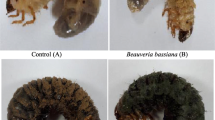Abstract
Arthrobotrys conoides Drechsler,Arthrobotrys oligospora Fressenius andMonacrosporium rutgeriensis R. C. Cooke, Pramer belong to the peculiar group of predactious fungi which trap and kill nematodes. We have found that these cultures produce nematode-attracting and nematicidal substances the production of which is potentiated in the presence of nematodes. Our method of nematode attraction assay is also described.
Similar content being viewed by others
References
Balan J., Gerber N. N.: Attraction and killing of the nematodePanagrellus redivivus by the predaceous fungusArthrobotrys dactyloides.Nematologica18, 163 (1972).
Balan J., Lechevalier H. A.: The predaceous fungusArthrobotrys dactyloides: induction of trap formation.Mycologia LXIX, 919 (1972).
Comandon J., deFonbrune P.: Recherches experimentales sur les champignons prédateurs de nématodes du sol: conditions de formation des organes de capture.Compt. Rend. Soc. Biol.129, 619 (1938).
Drechsler C.: Predacious fungi.Biol. Rev.16, 265 (1941).
Duddington C.: Fungi that attack microscopic animals.Bot. Rev.21, 377 (1955).
Giuma A. Y., Cooke R. C.: Nematotoxin production byNematoctonus haptocladus andN. concurrens.Trans. Brit. Mycol. Soc.56, 89 (1971).
Lawton J. R.: The formation of constricting rings in nematode-catching Hyphomycetes grown in pure culture.J. Exptl. Botany8, 50 (1957).
McBeth C. W., Bergeson G. B.: Methods of assaying nematocides.Phytopathology43, 264 (1953).
Monoson H. L., Galsky A. G., Griffin J. A., McGrath E. J.: Evidence for and partial characterization of a nematode attraction substance.Mycologia65, 78 (1973).
Monoson H. L., Ranieri G. M.: Nematode attraction by an extract of a predaceous fungus.Mycologia64, 628 (1972).
Olthof Th. H. A., Estey R. H.: A nematotoxin produced by the nematofagous fungusArthrobotrys oligospora Fresenius. Nature197, 514 (1963).
Pramer D.: Nematode-trapping fungi. Science144, 382 (1964).
Pramer D., Stoll N. R.: Nemin: a morphogenic substance causing trap formation by predacious fungi.Science129, 966 (1959).
Soprunov F. F.: Predacious hyphomycetes and their application in the control of pathogenic nematodes. US. Dep. of Agriculture and Nat. Sci. Foundation, Washington (1966).
Tarjan A. C.: Evaluation of various nematodes for use in contact nematocide tests.Proc. helminthol. Soc.22, 33 (1955).
Zopf W.: Zur Kentniss der Infectionskrankheiten niederer Thiere und Pflanzen.Nova Acta Leop.—Carol.54, 314 (1888).
Author information
Authors and Affiliations
Rights and permissions
About this article
Cite this article
Balan, J., Križková, L., Nemec, P. et al. Production of nematode-attracting and nematicidal substances by predacious fungi. Folia Microbiol 19, 512–519 (1974). https://doi.org/10.1007/BF02872918
Received:
Issue Date:
DOI: https://doi.org/10.1007/BF02872918




